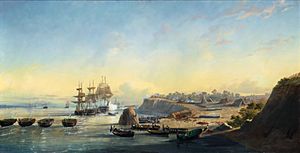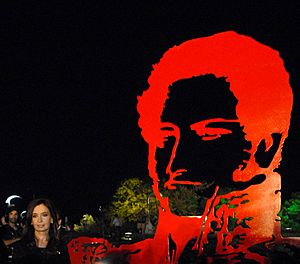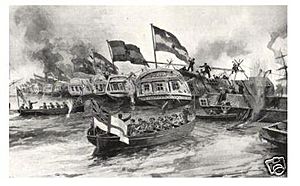Anglo-French blockade of the Río de la Plata facts for kids
Quick facts for kids Anglo-French blockade of the Río de la Plata |
|||||||
|---|---|---|---|---|---|---|---|
| Part of the Uruguayan Civil War | |||||||
 The Battle of Vuelta de Obligado, as depicted by François Pierre Barry |
|||||||
|
|||||||
| Belligerents | |||||||
Supported by: |
Supported by: |
||||||
| Commanders and leaders | |||||||
The Anglo-French blockade of the Río de la Plata was a five-year-long naval blockade. It was put in place by France and Britain against the Argentine Confederation. This country was led by Juan Manuel de Rosas. The blockade started in 1845. Its goal was to help the Colorado Party in the Uruguayan Civil War. It also stopped ships from reaching Buenos Aires.
British and French ships entered Argentina's rivers. They wanted to sell their goods there. Rosas had a policy called protectionism. This meant he wanted to protect Argentina's own businesses. He made it harder for foreign goods to be sold. This policy helped Argentina's economy grow. In the end, both Britain and France agreed to stop the blockade. They signed treaties in 1849 (Britain) and 1850 (France). These treaties recognized Argentina's full control over its rivers.
Contents
Why the Blockade Happened
Local Problems
Before this blockade, Buenos Aires faced another one. It was a French blockade from 1838 to 1840. Rosas resisted this blockade for a long time. He managed to create problems between France and Britain. This led France to lift its blockade in 1840.
France then tried to cause civil wars against Rosas. They helped Fructuoso Rivera against Uruguayan president Manuel Oribe. Oribe had to leave his position. Rosas welcomed Oribe as the true president of Uruguay. He did not recognize Rivera. This started the Uruguayan Civil War. In this war, the Blancos wanted Oribe back in power. The Colorados wanted Rivera to stay.
Rivera wanted to make Uruguay bigger. He hoped to add Paraguay and parts of Argentina and Brazil. But his plans failed. Oribe completely defeated Rivera's forces. This happened at the battle of Arroyo Grande. Rivera then had to defend Montevideo from Oribe's attack.
Brazil offered a military deal to Rosas. Brazil would help Rosas take Uruguay. In return, Argentina would help Brazil with its own conflicts. Rosas refused this offer. He believed it would go against Uruguay's independence.
International Reasons
Britain did not have many big interests in Buenos Aires. The war's main purpose was to improve relations with France. This alliance was called the Entente cordiale. It would help them work together in other places.
British interests in South America grew later. This happened when Texas joined the United States. Britain got cotton from Texas. They thought it would be easier to get cotton from South America. So, they looked at countries like Paraguay. Britain also spread stories against Rosas. They wanted public support for military action.
Two important French politicians were François Guizot and Adolphe Thiers. Thiers wanted France to keep fighting Rosas. He gave reasons like helping people and expanding trade. He called Rosas a harsh ruler. He also said Rosas was breaking a treaty about Uruguay's independence.
Guizot disagreed with Thiers. He did not think Rosas was breaking the treaty. He also did not believe France would gain much money. He did not want to keep a colony in the area. But in the end, Guizot agreed to the plan. He wanted to strengthen the alliance with Britain.
Brazil's representative, Miguel Calmon, met with British and French leaders. He asked Brazil to join the fight against Rosas. But Britain and France refused Brazil's help. They had their own reasons for not trusting Brazil.
The United States representative, William Brent, supported Rosas. He believed in the Monroe Doctrine. This idea said European powers should not interfere in the Americas. Brent offered to help make peace. But the British and French refused his help. They gave an ultimatum to Rosas. They demanded his forces leave Uruguay. If not, they would blockade Buenos Aires.
Starting the Conflict
The British and French ships acted quickly. They seized Argentina's entire navy. This happened even before the ultimatum's deadline. They took five Argentine ships. The French raised their flag on two, and the British on three. Argentine officers were sent back to Buenos Aires. William Brown, a key Argentine admiral, was forbidden to sail.
The next day, Anglo-French forces landed in Montevideo. They strengthened the city's defenses. Rivera thanked them, saying they saved Uruguay's independence. Many politicians in Buenos Aires criticized these actions.
Rosas knew Isla Martín García was hard to defend. He had removed most troops from it earlier. But he left a small group of old soldiers. They kept the Argentine flag flying. This showed that Argentina still claimed the island. It meant the Anglo-French would have to invade to take it. General Lucio Mansilla was ordered to fortify a point on the Paraná River. He chose a place called Obligado.
Blockade is Declared
The blockade was officially declared on September 18, 1845. They gave many reasons for it. They said Rosas continued the war despite their efforts. They also complained about how Buenos Aires newspapers described their actions. They claimed foreigners in Buenos Aires were mistreated.
Rosas held a meeting with diplomats from other countries. These included the United States, Portugal, and France. All of them said they had no complaints about how foreigners were treated. They also said reports of abuses were wrong. Rosas also presented a petition. It was signed by 15,000 British and French people living in Buenos Aires. They protested against the blockade. Rosas hoped this would change international opinion.
A French business representative, Durán de Mareuil, signed the petition. He wrote a document asking for the blockade to end. It included Rosas's demands. These demands included returning captured ships and islands. They also asked for recognition of Argentina's control over its rivers. This proposal was rejected in Montevideo. So, Mareuil went to Paris to present it to the French government.
Uruguay River Battles
The Anglo-French navy sailed up the Uruguay River in August. They announced they would block any ports supporting Oribe. They would even use gunfire to remove people. In response, ports closed to Anglo-French ships.
The navy moved to Colonia del Sacramento. Giuseppe Garibaldi and his Italian volunteers joined them. They had 28 ships. The city's defenders had only 300 soldiers. Garibaldi's Italian group landed and looted the city. Garibaldi later blamed a lack of discipline among his men.
The navy then moved to Martín García. French troops defeated the small Argentine force there. The Argentine flag was taken down. The flag of Uruguay was put up instead. The island was left empty.
The ships then went into the Uruguay river. The looting of Gualeguaychú was even worse than in Colonia. Garibaldi described it as a rich place. He said they got horses, clothes, and money there. This money was given to his poor soldiers. Garibaldi's looting was worth almost 30,000 British pounds.
Garibaldi was defeated at Paysandú and then at Concordia. He then took and looted Salto. By November, the Anglo-French navy controlled the entire Uruguay River.
Paraná River Battles
After Montevideo was safe, the British and French planned to sail up the Parana river. They wanted to reach Corrientes and Paraguay. Their goal was to force the Argentine Mesopotamia region to become a new country. They also wanted to control both rivers.
The convoy had three steamboats and many armed sailboats. These ships protected 90 merchant vessels. These merchant ships were from different countries. Argentina warned foreign diplomats that ships entering the Paraná without permission would be seen as pirates. But the messages were delayed. So, all 90 merchant ships joined the operation.
The Anglo-French forces had very advanced weapons. They used new cannons and Congreve rockets. These rockets were used for the first time in South America. They expected their firepower to be very strong.
The convoy stopped to check the situation. They thought they would sail easily. But they found that Lucio Mansilla had built many forts along the river. So, the merchant ships stayed behind. The combat ships went ahead to clear the way. The most important fort was at Obligado.
The Battle of Vuelta de Obligado
At Obligado, the Paraná River is only 700 meters wide. It also has a difficult turn for sailboats. Mansilla placed 24 boats across the river. These boats held three thick chains to block the river. The west side of the river had four forts. Argentina's biggest cannons were small. The Anglo-French navy's cannons were much larger. The land was defended by soldiers and volunteers. Many Argentine cannons were operated by British sailors. These sailors had been captured from the Argentine fleet. They chose to fight for Argentina.
The first steamboats arrived at Obligado on November 18. They stopped out of cannon range. The attack began on November 20. Lucio Mansilla encouraged his troops. He told them to fight for their nation's freedom.
The first ship to move forward was the San Martín. It was trying to break the chains. But the wind stopped, and it got stuck. It was hit over a hundred times. Two cannons were destroyed, and many sailors died. Finally, its anchor chain broke, and it moved away. Other ships also had to retreat.
When the Republicano ran out of ammunition, its captain blew it up. He did not want it to be captured. Then, the steamboats reached the chains. They were not affected by the lack of wind. Their powerful guns were too strong for the Argentine cannons. The Fulton broke the chains. The wind started blowing again. The ships moved forward. The Argentine defenses slowly ran out of ammunition. By the end of the day, all forts were destroyed. About 250 Argentine soldiers died, and 400 were hurt. The Anglo-French fleet stayed at Obligado for 40 days to make repairs.
What Happened After Obligado
News of the battle spread in 1846. Many newspapers that had criticized Rosas now supported him. Brazilian newspapers called Rosas a great South American hero. José de San Martín, a famous Argentine general, wrote a letter supporting Rosas. He even offered to help fight. He also wrote to a British newspaper. He explained that taking Buenos Aires by force would be almost impossible.
The convoy continued its journey after repairs. But only 52 of the original 90 merchant ships went on. The others returned to Montevideo. Mansilla attacked again at Tonelero and Acevedo. But the ships were not badly damaged. They could fire from a safe distance.
Mansilla put up a stronger fight at San Lorenzo on June 4, 1846. This was the same place where San Martín had fought a famous battle. The forts here were hidden. They surprised the Anglo-French navy. Many merchant ships crashed into each other. The steamships fired for over four hours. All ships were hit during the fight.
The Fulton reached Asunción, Paraguay. Its goal was to recognize Paraguay's independence. It also wanted to get Paraguay to fight Rosas. And it wanted to sign a trade agreement. But Paraguay's leader, Carlos Antonio López, did not agree to the British terms. The trade mission failed. Corrientes and Paraguay were not as rich as expected. Most products were brought back.
The return trip was difficult. Many ships were damaged. Mansilla was rearming the forts north of San Lorenzo. So, they asked Montevideo for more ships. The Philomel raced back to Montevideo. The British steamboats Lizard and Harpy went to meet the convoy. But the Lizard was badly damaged in a fight.
Mansilla prepared a strong defense at Quebracho. This was for the returning convoy. He did not use chains this time. The ships would be moving downstream. This new attack was very successful. Argentine cannons hit the enemy ships easily. Merchant ships tried to hide behind warships. Two merchant ships sank. Others had to throw their cargo into the river. The steamboats were hit hard. The Harpy was disabled. The Gorgon was badly damaged. After three hours, the ships escaped. Four damaged merchant ships were set on fire to prevent capture.
Ending the Conflict
After the Paraná expedition failed, Ouseley asked his government for many soldiers. He wanted 10,000 British and 10,000 French troops. He also wanted an open declaration of war. But his government had already decided to end the conflict. Thomas Samuel Hood was sent to Buenos Aires. He had orders to negotiate peace.
The battle of Vuelta de Obligado changed how the world saw the conflict. Hood also pushed for peace because Rosas had stopped paying Argentina's debt to Britain. A long conflict would hurt British banks.
Hood agreed on peace terms with Rosas. But Ouseley and Deffaudis refused to follow them. Hood returned to Britain with Rosas's proposal. Britain wanted to end the conflict. But they did not want to accept terms that looked like a surrender. So, Britain and France sent new diplomats. They pretended to agree with Hood's terms. But they secretly tried to change them. Rosas realized their trick and refused.
Rosas finally signed the Arana-Southern Treaty with Britain on March 3, 1849. It followed the terms Hood had negotiated. Britain would return captured ships and Martín García island. They would remove their troops from Uruguay. They would accept Argentina's control over its rivers. Finally, the British navy would fire a 21-gun salute to Argentina's flag.
Negotiations with France took longer. France had strong national pride at the time. Another defeat would hurt them. Rosas refused to negotiate unless the French navy left Uruguay. He also refused to recognize the French diplomat. Rosas finally agreed on August 31, 1850. He made only small concessions. The French ship carrying the diplomat would also fire a 21-gun salute to Argentina's flag.
Looking Back at History

Historians in Argentina have different views on this conflict. Some historians see it as a very important event. They compare it to Argentina's fight for independence. Other historians do not think it was as important.
For example, on November 18, 2010, Argentina celebrated its first National Sovereignty day. This day remembers the Battle of Vuelta de Obligado. A newspaper interviewed different historians.
Some historians say the battle's importance is too high. They say it was a defeat because the Anglo-French navy still moved north. They believe the blockade ended because Britain changed its policy. Other historians argue that the blockade failed in its main goals. They could not create a new country in Argentina. They also did not fully control the Paraná River.
Historians also disagree on whether the battle was hidden from history. Some say it was, while others say it was always mentioned in books.
Overall, the British goal was to bring peace to the region. They also wanted to secure Uruguay's independence. And they wanted to improve trade with all the countries there. The British mission was seen as a failure. It showed that Britain struggled to deal with certain governments.
See Also
|



